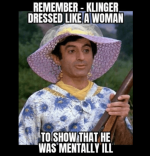Doing what parents ask for sounds like a path for success for a politician . But that is just me .Um... OW... first off, hope your eye is okay. Just keep an... ahem... eye... on it
As for Trudeau - he's a dick and I don't bother listening to most of his stuff anymore. That said, I am glad he spoke out against Higgs. I find it hilarious that his fuckery with 713 is what might just get his ass kicked OUT of being Premier.
2SLGBTQQIA+
- Thread starter B00Mer
- Start date
You are using an out of date browser. It may not display this or other websites correctly.
You should upgrade or use an alternative browser.
You should upgrade or use an alternative browser.
Served with honor and increasing responsibility/reliability for all 11 years of the Korean War.
Thank God it wasn't a real long war like WWII which lasted decades.Served with honor and increasing responsibility/reliability for all 11 years of the Korean War.
And continues to this very day!Thank God it wasn't a real long war like WWII which lasted decades.
Hey, Ski, I just had a GREAT idea for a new WWII movie/television programme! Ready?
"REMFs: The Battle Stateside. . ." Follow the wacky adventures of the 327th Supply Battalion as they drink, screw, and grift their way through the war, whilst writing themselves up for combat medals!
"REMFs: The Battle Stateside. . ." Follow the wacky adventures of the 327th Supply Battalion as they drink, screw, and grift their way through the war, whilst writing themselves up for combat medals!
Other than the setting and the battalion name, I am sure I have seen several versions of this movie.Hey, Ski, I just had a GREAT idea for a new WWII movie/television programme! Ready?
"REMFs: The Battle Stateside. . ." Follow the wacky adventures of the 327th Supply Battalion as they drink, screw, and grift their way through the war, whilst writing themselves up for combat medals!
Anything worth doing is worth ripping off for a few bucks.Other than the setting and the battalion name, I am sure I have seen several versions of this movie.
So, where were your safety glasses?Thank you. I’m on the outside, but do find it interesting as it’s evolving. The three years of Covid really saw it explode as people had more time on their hands to make up weird stuff….& and not just on this topic either. I didn’t miss so much is a day of work during Covid so….I look at things differently maybe?
I’m just taking a quick cooldown break as it’s about 90° here and I’ve been pruning trees, and I stabbed myself in the right eye (got the eye closed in time) but I am living monocularly as I punched the eyeball pretty good through the eyelid.I will need depth perception to go back and finish what I was doing.
I’ve watched a couple of different Australia, newscasters, laughing at Trudeau with an evolving 2SLGBTQ++etc…things that he must practice on his own so he could throw them out semi-casually in topics that really have nothing to do with that, but almost like a extremely drawn out exclamation mark/sidetrack to show… something (?) and then he will diverge back to what he was talking about, but probably not asked about.
In the spirit (singular, not plural) of inclusivity and humour, I think I’m going to make up a new series of jumbled letters and try and work it into the conversation randomly like Trudeau with a straight face, and then veer back to what I was talking about…. As if I didn’t say them just to see if anybody actually asks about (?) or ignores that portion of a sentence. I think it will end in LMNOPee+ whatever the series of letters is.
I can get my right eye open briefly again, but it’s foggy as hell. Watering hard but I think that’s a great sign! Didn’t get any wood in the eye this time but scored up the eyelid good I’m sure. Sure, glad that an eyeball is compressionable.Might have a black eye for Canada Day without a cool (real) story to go with it.
I saw one a few days ago on FB that I don't know was real or made up by someone to make a point. The black stripe, and one of the other ones, were bent around to clearly make a swastika in the middle of the flag. One can never be sure of anything on fb anymore. Especially after their "fact checkers" get done with it.I saw this on facebook earlier and of course now its gone. The trans and 2 spirited ones are the weird ones that run mostly vertical. The black stripe is for people of colour (how they got in here who knows) and the horisontal ones are stuff like progressive and shit -- adjectives rather than any groups. The LGB is also completely missing from the flag now. And if you are raising one without the mostly vertical stuff you are transphobic or at the very least in the stone age.
From what I have read so far, Higgs bill is very reasonable.To the Higgs/713 thing, really it's just a transphobe amending something already in place because he got one (not hundreds as he claimed, at least, not that he's proven) complaint about it. And with that bit in his teeth, he went the route of the extremists in the US, in that way. Honestly I'm more surprised with how positive people have been in general about it, vs. what it could be.
big pharma funded and 'social standards' fascistbook fart-checkers are always sticking their noses where they've no business being.I saw one a few days ago on FB that I don't know was real or made up by someone to make a point. The black stripe, and one of the other ones, were bent around to clearly make a swastika in the middle of the flag. One can never be sure of anything on fb anymore. Especially after their "fact checkers" get done with it.
From what I have read so far, Higgs bill is very reasonable.
So reasonable his own party wants him out and most of the province is done with his BS.
When did all the parents leave ?So reasonable his own party wants him out and most of the province is done with his BS.
You should read the news. This decision is quite popular outside the party as well. Just the fact that it has a bunch of leftys peeing their little panties makes it worthwhile.So reasonable his own party wants him out and most of the province is done with his BS.
You should read the news. This decision is quite popular outside the party as well. Just the fact that it has a bunch of leftys peeing their little panties makes it worthwhile.
Oh Taxy.
I live in NB and have been keeping up on this.
It's not as popular as you think and perhaps it's you who needs to read up on the issue.
As stated, the ass has enough for a leadership review against him, BECAUSE of this issue being the straw that broke the camels back. And to be transparent, I've no love for the Con's in NB, especially Dorothy Shepherd, yet her leaving was HILARIOUS...
No, hun, this isn't just "leftys" or a left issue, this has people in his own party telling him he fucked up.
Best you run the numbers and get back to us .Oh Taxy.
I live in NB and have been keeping up on this.
It's not as popular as you think and perhaps it's you who needs to read up on the issue.
As stated, the ass has enough for a leadership review against him, BECAUSE of this issue being the straw that broke the camels back. And to be transparent, I've no love for the Con's in NB, especially Dorothy Shepherd, yet her leaving was HILARIOUS...
No, hun, this isn't just "leftys" or a left issue, this has people in his own party telling him he fucked up.
I am admittedly not up on this Policy 713 & how it relates to New Brunswick…though I do have the time this afternoon (now that I’m back to binocular vision) to read a couple of quick articles, and a Wiki page on this, then a story from the outside, looking into Canada (interesting to get that perspective usually) into this thing. Even with a short “ dipping my mental toe in the water” here, I’m seeing some conflicting information, & I’m still ignorant on the topic. This is the slight change the wording, with a big change in meaning, that stands out to me anyway:
This from the BBC: Initially passed in 2020 after a decade of consolations, Policy 713 in its original form asked for parental consent in order to formally change students' names or pronouns, but made it mandatory to use a student's preferred name “if it was not possible” to get permission from a parent.
It also allowed students to participate on sporting teams and use washrooms consistent with their gender identity, etc…

 www.bbc.com
www.bbc.com
That’s very different (in my mind anyway) between “not informing” or “without the consent of” a parent of a child under the age of 16 in changing their child’s name and choice of pronouns.
This from the CBC, that is soooo similarly written that I almost think one plagiarized the other, but some keywords are very different: Its original version allowed all students to be referred to by their preferred pronouns and names “without involving their parents.” Teachers had to get consent from the students before sharing that information with their family.
It’s small details and changes in wording, and I’m just using these two examples between the BBC & CBC, that dramatically change the meaning in the way things are portrayed in the media, and perhaps in the way things are perceived on the different sides of this issue.
“If it was not possible to get permission from a parent” & “ without involving their parents” to me seem like two VERY different things, so potentially two Very different discussions even.
So, a quick dig comes up with the original PDF from three years ago (Aug.17th,2020):
Then on page 5 at 6.3.2 it states this:

What’s ACTUALLY written there isn’t actually what either the CBC or the BBC are claiming…so no wonder there’s much confusion and conflict on this.
Going back to the original legislation, a better explanation of, “a plan will be put in place to support the student in managing the use of the preferred name in the learning environment.” THAT’S the Weaselly part of those six pages that would lead to issues at a later date!!! This was poorly written from the get-go.
This from the BBC: Initially passed in 2020 after a decade of consolations, Policy 713 in its original form asked for parental consent in order to formally change students' names or pronouns, but made it mandatory to use a student's preferred name “if it was not possible” to get permission from a parent.
It also allowed students to participate on sporting teams and use washrooms consistent with their gender identity, etc…

Policy 713: LGBT school policy change causes political turmoil in Canada
In New Brunswick, changes to a pronoun policy for students threaten the premier's political future.
That’s very different (in my mind anyway) between “not informing” or “without the consent of” a parent of a child under the age of 16 in changing their child’s name and choice of pronouns.
This from the CBC, that is soooo similarly written that I almost think one plagiarized the other, but some keywords are very different: Its original version allowed all students to be referred to by their preferred pronouns and names “without involving their parents.” Teachers had to get consent from the students before sharing that information with their family.
It’s small details and changes in wording, and I’m just using these two examples between the BBC & CBC, that dramatically change the meaning in the way things are portrayed in the media, and perhaps in the way things are perceived on the different sides of this issue.
“If it was not possible to get permission from a parent” & “ without involving their parents” to me seem like two VERY different things, so potentially two Very different discussions even.
So, a quick dig comes up with the original PDF from three years ago (Aug.17th,2020):
Then on page 5 at 6.3.2 it states this:

What’s ACTUALLY written there isn’t actually what either the CBC or the BBC are claiming…so no wonder there’s much confusion and conflict on this.
Going back to the original legislation, a better explanation of, “a plan will be put in place to support the student in managing the use of the preferred name in the learning environment.” THAT’S the Weaselly part of those six pages that would lead to issues at a later date!!! This was poorly written from the get-go.
Anywho….When the Ontario government amended the human rights code in 1986 to include sexual orientation as a prohibited ground of discrimination, there was no talk of drag queen story times, putting biological males into women’s prisons or having naked people parading in front of children with legal impunity.
Nor did it envision transitioning biological males competing with female athletes, gender-neutral bathrooms, or schools not informing parents of their child’s gender identity.
The intent of the amendment was to make sexual orientation a prohibited ground of discrimination – similar to race, place of origin, colour, disability and other factors – in five areas; employment, housing, services, unions and vocational associations and contracts.
The argument in favour of the amendment – as put forth in the Legislature by then Ontario attorney-general Ian Scott, who led off the debate – was based not on the mandatory celebration of sexual differences, but on equal rights for all citizens in the name of “tolerance.”

 apple.news
apple.news
“The purpose of this legislation is not to exalt their status, to permit them to break laws, or to alter any of the fabric of our society, but to give them the least they are entitled to as human beings …

 apple.news
apple.news
“It is not a question of giving privileges, extra rights or special status, and it never was. It was always a question of inviting those who provide services to examine whether, on an individual basis, the applicant should be entitled to that service.” Of course, that was then and this is now.
As evidence of the times back then, Scott was himself a gay man, but didn’t publicly reveal his homosexuality – although it was an open secret at Queen’s Park – until 1993, when his longtime partner died of HIV/AIDS. Scott, a highly respected lawyer, died in 2006.
In 2012, the then-Liberal government of Dalton McGuinty passed amendments to the human rights code to include “gender identity” and “gender expression” as prohibited grounds of discrimination.
In light of this, it’s not hard to understand the societal tension caused by the transition over time from “tolerance” to what often seems the mandatory celebration of any and all initiatives advertised to the public as celebrating diversity on the issues of sexual orientation, gender identity and expression.
For example, professional athletes forced to make public apologies for the “thought crime” of not being on board with pride nights, or parents automatically condemned as haters for arguing it’s their job to teach values to their children, not the job of their child’s school.
Of course, there are people who hate others on the basis of their sexual orientation and gender identity. That’s wrong and it’s why we rightly have laws against such discrimination.
But to argue that any hesitancy about any government action ostensibly designed to enhance gay, lesbian and gender-identity rights is by definition based on hatred is also wrong and inaccurate.
Nor did it envision transitioning biological males competing with female athletes, gender-neutral bathrooms, or schools not informing parents of their child’s gender identity.
The intent of the amendment was to make sexual orientation a prohibited ground of discrimination – similar to race, place of origin, colour, disability and other factors – in five areas; employment, housing, services, unions and vocational associations and contracts.
The argument in favour of the amendment – as put forth in the Legislature by then Ontario attorney-general Ian Scott, who led off the debate – was based not on the mandatory celebration of sexual differences, but on equal rights for all citizens in the name of “tolerance.”
GOLDSTEIN: Tolerance should work both ways on issues of gender identity — Toronto Sun
When the Ontario government amended the human rights code in 1986 to include sexual orientation as a prohibited ground of discrimination, there was no talk of drag queen story times, putting biological males into women’s prisons or having naked people parading in front of children with legal...
“The purpose of this legislation is not to exalt their status, to permit them to break laws, or to alter any of the fabric of our society, but to give them the least they are entitled to as human beings …
WARMINGTON: Female rugby players complain trans opponent hits too hard — Toronto Sun
Female rugby players are not used to feeling like they have been hit by a bus on the field. Or a truck. A veteran female rugby player, who plays for the Stoney Creek Camels senior women’s team, said she was hit so hard in a recent game, it felt like a man delivering the tackle. If this had...
“It is not a question of giving privileges, extra rights or special status, and it never was. It was always a question of inviting those who provide services to examine whether, on an individual basis, the applicant should be entitled to that service.” Of course, that was then and this is now.
As evidence of the times back then, Scott was himself a gay man, but didn’t publicly reveal his homosexuality – although it was an open secret at Queen’s Park – until 1993, when his longtime partner died of HIV/AIDS. Scott, a highly respected lawyer, died in 2006.
In 2012, the then-Liberal government of Dalton McGuinty passed amendments to the human rights code to include “gender identity” and “gender expression” as prohibited grounds of discrimination.
In light of this, it’s not hard to understand the societal tension caused by the transition over time from “tolerance” to what often seems the mandatory celebration of any and all initiatives advertised to the public as celebrating diversity on the issues of sexual orientation, gender identity and expression.
For example, professional athletes forced to make public apologies for the “thought crime” of not being on board with pride nights, or parents automatically condemned as haters for arguing it’s their job to teach values to their children, not the job of their child’s school.
Of course, there are people who hate others on the basis of their sexual orientation and gender identity. That’s wrong and it’s why we rightly have laws against such discrimination.
But to argue that any hesitancy about any government action ostensibly designed to enhance gay, lesbian and gender-identity rights is by definition based on hatred is also wrong and inaccurate.

